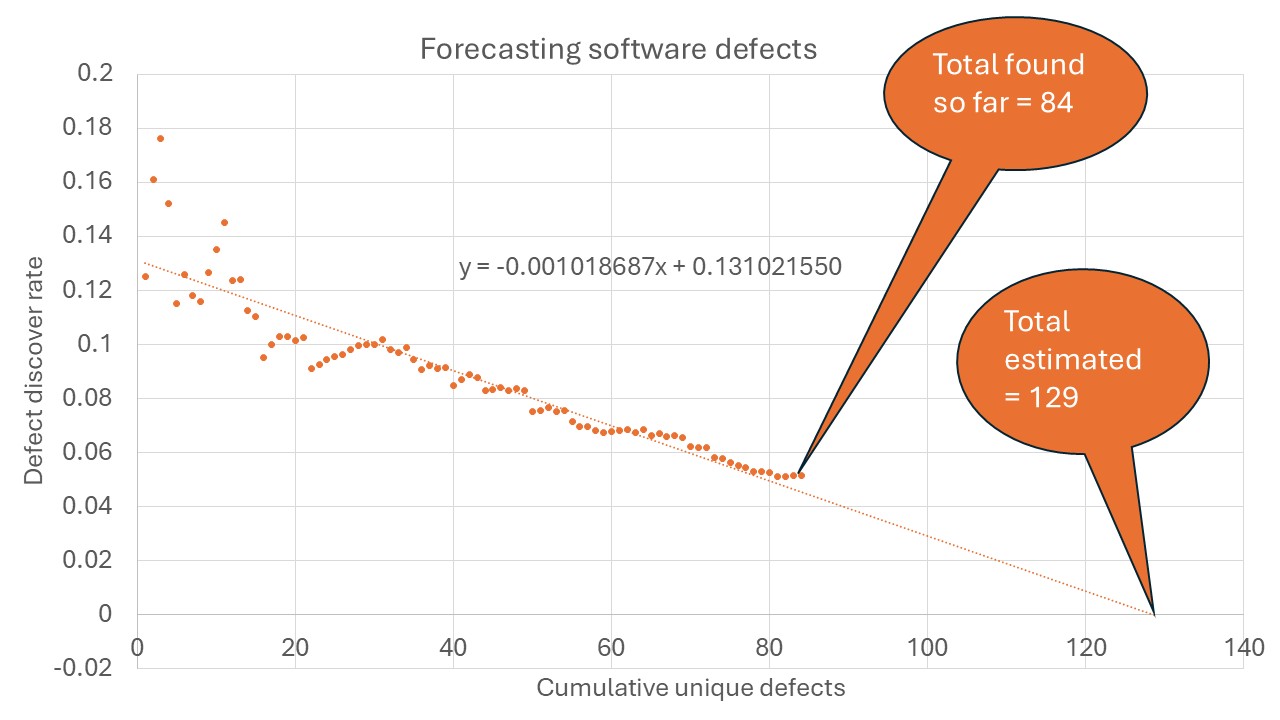Learn How to forecast software defects
Why do I need to forecast defects?
Technical debt can significantly impact project timelines and resources, often leading to delays in future program increments. Poor decisions in one software release can create a cascading effect, jeopardizing the success of subsequent projects. To avoid this, it’s crucial to proactively manage defects and forecast software defects before they lead to a disaster or technical debt. Here’s a breakdown of the escalating costs associated with neglected software defects.
Cost of latent software defects increases 42% every 4 years. Defects that remain in the codebase and are not addressed grow more expensive over time. The longer they sit, the more difficult and costly they become to fix.
Cost of fixing defects increases 21% every 2 years. This highlights how delaying bug fixes directly impacts your budget. As a project evolves, the codebase becomes more complex, making it harder to isolate and resolve issues.
Cost of failed software projects increases 46% every 4 years. When technical debt and unmanaged defects accumulate, they can eventually lead to outright project failure, resulting in substantial financial losses and wasted resources.
Learning how to forecast software defects provides a proactive solution. By predicting and addressing potential issues early, you can mitigate these rising costs, protect your project schedule, and ensure the long-term success of your software.
Forecasting software defects have value regardless of management decisions
Our data shows that when people guess how many defects remain they are often off by several orders of magnitude. Even if/when management chooses not to fix the remaining defects, knowing how many defects remains can serve as a guide for help desk support when the defects are found by the customers. The effort required to forecast software defects is minimal compared to the effort required to track them when the software is deployed.

A Practical Approach to Forecasting Softare Defects
Forecasting defects starts with a solid understanding of your defect data and the ongoing activities in your development and testing cycles.
1. Data Analysis: Begin by thoroughly examining your defect data. This includes:
- Defect Discovery Rate: How many new defects are being found each day or week?
- Defect Fix Rate: How quickly are defects being resolved and verified?
- Defect Severity: Are you finding more critical bugs or minor issues?
2. Contextual Understanding: You need to correlate this data with what’s happening in your development and testing efforts. This involves considering factors such as:
- The current state of the software (e.g., in early alpha, feature-complete, or in regression testing).
- The size and experience of your testing team. Changes in your team will effect the rate of the defect discovery.
- The number of new features being added or modified. Whenever new features are added, the defect discovery rate will go up relatively to the amount of
3. Forecasting Tools: Once you have a clear picture, you can use various tools to forecast the remaining defects. You don’t need highly complex statistical software. Simple methods and tools are often sufficient:
Spreadsheets: A basic spreadsheet can plot your defect discovery rate over time. By looking at the trend—whether the rate is flattening or declining—you can get a good idea of how many defects are left.
Growth Models: These mathematical models use your historical defect data to predict future trends. While some can be complex, many are based on straightforward principles and can be implemented with simple tools.
Basic Statistical Methods: A simple visual inspection of the defect discovery curve can be incredibly insightful. If the curve is flattening out, it suggests you’re approaching the point where most defects have been found.
By focusing on these core principles, you can effectively forecast how many defects remain and estimate the additional testing effort needed to find them, without needing an overly complicated approach.
Forecast software defects in testing
VIRTUAL SELF GUIDED-
Forecase software defects during testing. Determine how many remain and the effort required to discover them.
-
Dermine if the release criteria can be met with current test schedule and resources
-
Determine how many test hours and assets are needed to reach the objective
-
Forecast failures, failure rate, mean time to failure, availability, site reliability
Knowledge Base
Mission ready software has 4 decades of forecasting software defects.
Compliant
The methods are recommended by the IEEE 1633 clauses 5.4 and 6.3
Flexible
This class is available as virtual self guided or DVD. Virtual instructor guided or in person instruction guided classes are available upon request.
Cost effective
Some of the models for defect forecasting are overly complicated. We fixed that. We have a method to forecast software defects without having to track test hours. See our paper “Estimating software reliability without test hours” at the RAMS 2025 Symposium session 5B.
TERMS & CONDITIONS
As per the terms and conditions page of this website, software training classes are non-refundable.